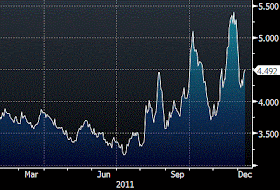 Unlike most of its competitors, Goldman Sachs does not have a deposit base or retail branches, making it vulnerable to liquidity risk. JPMorgan for example has a vast pool of overnight and term deposits (both retail and institutional) they can access during tight liquidity periods. Goldman however tends to rely on capital markets for funding, forcing it not only pay higher financing rates, but making its funding costs extremely volatile, translating into unstable earnings and high stock volatility.
Unlike most of its competitors, Goldman Sachs does not have a deposit base or retail branches, making it vulnerable to liquidity risk. JPMorgan for example has a vast pool of overnight and term deposits (both retail and institutional) they can access during tight liquidity periods. Goldman however tends to rely on capital markets for funding, forcing it not only pay higher financing rates, but making its funding costs extremely volatile, translating into unstable earnings and high stock volatility.The chart below shows the yield on Goldman's 2016 notes. The yield can easily swing some 100 basis points in a short period, making it tough to manage the business, creating uncertainties about future revenues.
 |
| GS 3 5/8, 2-2016 notes (Bloomberg) |
 |
| Source: BankRate.com |
Chartered Quality Institute: The decline [in trust] has been blamed on a series of public crises at organizations including the ongoing backlash against bankers, fueled by widely publicized problems at Goldman Sachs. The survey showed that only 25% of Americans now trusted banks, down from 33% in 2009 and 71% before the financial crash.As usual in situations like this, GS gets creative and offers "structured" CDs that may differentiate its product from the standard sleepy bank product paying under 1.2% per year. In this case the product is a 4-year CD linked to the performance of the DJI index. This type of product is not unique and was often used by banks in the 90s, particularly in Europe. But not by Goldman, because they were not a bank holding company then.
This particular CD provides a minimum return of 2% over the life or roughly 0.5% per year - guaranteed (vs. say 1.2% for a standard CD). Principal is FDIC insured. The maximum return is the sum (not compounded) of monthly returns on the Dow, capped at 1.5%-2% per month. The final return therefore is what some refer to as "path dependent". Even if the Dow ends up in the same place, a more volatile path will produce a lower return on the CD because the holder would be subject to full drops in the index, while monthly increases would be capped. The holder is in effect "short volatility".
Goldman on the other hand views this as purely a financing product and therefore will hedge it. Here is what the hedge will look like:
1. Goldman will buy a 4-year call on the Dow Jones index (or a group of stocks that closely resembles the index). The call will be struck close to at-the-money.
2. On a monthly basis Goldman will sell short term (around a month in maturity) calls that are 1.5-2% out-of-the money.
By cutting the guaranteed rate on the CD from "market" by some 0.7% and by selling short-term calls on a monthly basis, Goldman can finance the long-term call option (above) and the FDIC insurance costs. On average after accounting for the net cost of the hedges, Goldman's funding cost will likely be close to a typical CD rate, certainly much cheaper than issuing a bond. The straight sum of monthly returns vs. the compounding makes it even cheaper.
Obviously a sophisticated client can replicate this structure in her own portfolio and get a better return. But for a typical retail investor who wants some upside, this might look interesting.
If it works, Goldman can diversify its funding sources and more effectively compete with banks that have a retail presence. It may also open a new funding avenue for Morgan Stanley, which is is even more vulnerable than Goldman to funding risks.
Goldman Sachs Bank DJIA MLD Sum of Mo Incr 4Yrs 12-30-11
SoberLook.com